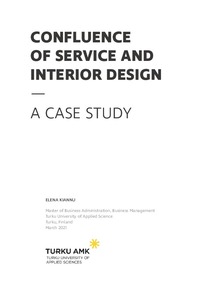Confluence of service and interior design : a case study
Kiannu, Elena (2021)
Kiannu, Elena
2021
All rights reserved. This publication is copyrighted. You may download, display and print it for Your own personal use. Commercial use is prohibited.
Julkaisun pysyvä osoite on
https://urn.fi/URN:NBN:fi:amk-202103283921
https://urn.fi/URN:NBN:fi:amk-202103283921
Tiivistelmä
Interior design projects are often focused on the aesthetics and functionality of a space while service design is applied separately on the services or products within the space. The present Master’s thesis aims to explore the potential connection between service and interior design, and the way these design disciplines can enrich each other. This study argues that interior design projects can benefit from the use of the service design tools and methods of linking space with services.
The theory section of the present thesis discusses the topics of design thinking, service design, interior design, and their relation to each other. The focus is on the processes, methods, and tools of design disciplines. The discussions show that processes, tools and methods of both design thinking and service design have been extensively studied, while less attention has been paid to the topic of interior design processes, methods, and tools in academic research. Most information about interior design processes, tools and methods is available in non-academic literature. Furthermore, the confluence of interior and service design has been studied even less. The goal of the thesis is to close these research gaps and answer the main research question of the study, which is: how can service design and interior design be combined?
Qualitative research methods were actively used in the thesis, where experts´ interviews helped to explore the topic and case study was used as the core method. The case study includes several research methods and tools from both interior and service design, such as benchmarking, observation and interview.
The study demonstrates that interior design projects can benefit from the use of service design methods and tools. The case study results reveal that by involving service design within interior design projects, it is possible to improve the service providing process by turning the space into the continuation of the service. In addition, the use of design thinking allows to create new transdisciplinary tools by combining various existing tools from service and interior design to better fit the needs of the project at hand.
The theory section of the present thesis discusses the topics of design thinking, service design, interior design, and their relation to each other. The focus is on the processes, methods, and tools of design disciplines. The discussions show that processes, tools and methods of both design thinking and service design have been extensively studied, while less attention has been paid to the topic of interior design processes, methods, and tools in academic research. Most information about interior design processes, tools and methods is available in non-academic literature. Furthermore, the confluence of interior and service design has been studied even less. The goal of the thesis is to close these research gaps and answer the main research question of the study, which is: how can service design and interior design be combined?
Qualitative research methods were actively used in the thesis, where experts´ interviews helped to explore the topic and case study was used as the core method. The case study includes several research methods and tools from both interior and service design, such as benchmarking, observation and interview.
The study demonstrates that interior design projects can benefit from the use of service design methods and tools. The case study results reveal that by involving service design within interior design projects, it is possible to improve the service providing process by turning the space into the continuation of the service. In addition, the use of design thinking allows to create new transdisciplinary tools by combining various existing tools from service and interior design to better fit the needs of the project at hand.
